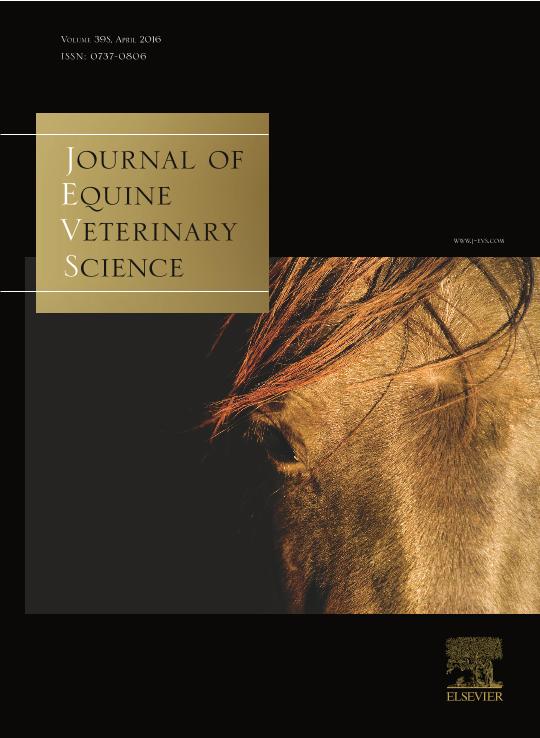Evento
Seropositivity of Equine infectious anemia by 2005 to 2014 in provinces of north-west of Argentina
Storani, Carlos Alberto; Jacobo, Roberto Armando; Cipolini, M. F.; Martínez, D. E.; Espasandin, Ana Gabriela ; Paine, V.; Godoy, J. A.
; Paine, V.; Godoy, J. A.
 ; Paine, V.; Godoy, J. A.
; Paine, V.; Godoy, J. A.
Tipo del evento:
Conferencia
Nombre del evento:
10th International Equine Infectious Diseases Conference
Fecha del evento:
04/04/2016
Institución Organizadora:
University of Kentucky;
Título de la revista:
Journal of equine Veterinary Science
Editorial:
Elsevier
ISSN:
0737-0806
Idioma:
Inglés
Clasificación temática:
Resumen
Equine infectious anemia (EIA) is a disease caused by a lentivirus specific from equidae family. It had been diagnosed in all continents except in Antarctica. Morbidity and mortality depends on the sensibility of the population and the virus strains. The clinics symptoms of the acute presentation tend to be unspecific and infected horses often recover and remain as chronic carriers. EIA virus (EIAV) infection can result in either an acute or chronic (swamp fever) disease that typically transitions to a life-long,unapparent (asymptomatic) infection. The virus of EIA is transmitted by blood or contaminated blood derivatives, but in the nature the main way of transmission is by bloodsuckinginsects. Diagnosis is based on serological testing, being the agar gel immunodiffusion test (AGID) the test prescribed by OIE for international trade of horses. The purpose of this study was to evaluate EIA presentation in northern-west provinces of Argentina, based on results of AGID from serum samples. The results were compiled from a laboratory which belongs to a netof laboratories regulated by the sanitary authorities (SENASA) and is located in Corrientes city. Datum obtained correspond to 56.391 samples obtained from equines of Corrientes (n¼48.661), Misiones (n¼6.722) and Chaco (n¼1.008) provinces, analyzed between 2005 and 2014. A total of 1.954 animals were positives in this period. Percentage of positivity (PP) was determinate, discriminated by province and year. The average PP was determinate by province for the period between 2005 and 2012.In all cases, tendencies shows the decrement of PP from 2005 to 2012 (Misiones, Chaco) or 2014 (Corrientes). InCorrientes province, the rank of PP was 6,03% (2005) to 1,24% (2013); in Misiones was from 4,25% (2005) to 0,8% (2010) and in Chaco was from 20,05% (2008) to 0% (2005 and 2006). The average PP for the period between 2005 and 2012 was 3,77%, 3, 35% and 5,91% in Corrientes, Misiones and Chaco, respectively. Since that analysis was made from a non-randomly samplingfrom serum that arrives to diagnosis in laboratory, this findings cannot be expressed in terms of prevalence. For the same reasons, the PP reached is lower than those reported for equines of the same areas in prevalence studies, because the animals that are frequently controlled are those destined to sports and shows activities and their situation does not reflect what occurs in equines destined to do farm tasks, which are often excluded from controls and where the disease prevalence is higher. This analysis shows, however, a tendency which is in agreement with reported by other authors for the provinces studied, with ahigher prevalence in Chacowhen compared with Corrientes and Misiones provinces.
Palabras clave:
Diagnosis
,
Serology
,
Equine
Archivos asociados
Licencia
Identificadores
Colecciones
Eventos(CCT - NORDESTE)
Eventos de CTRO.CIENTIFICO TECNOL.CONICET - NORDESTE
Eventos de CTRO.CIENTIFICO TECNOL.CONICET - NORDESTE
Citación
Seropositivity of Equine infectious anemia by 2005 to 2014 in provinces of north-west of Argentina; 10th International Equine Infectious Diseases Conference; Buenos Aires; Argentina; 2016; S34-S35
Compartir



